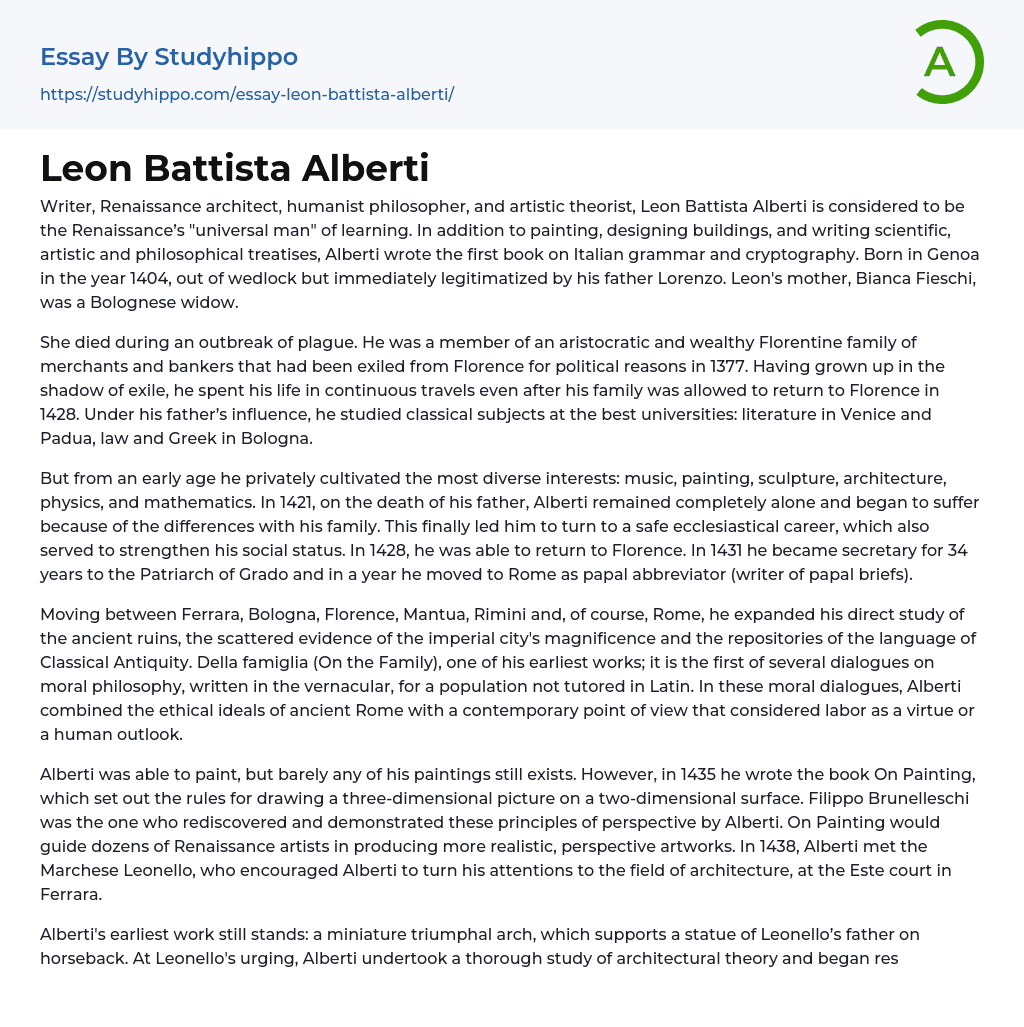Leon Battista Alberti, a writer, Renaissance architect, philosopher of humanism, and theorist of artistry, is highly regarded as the "universal man" of the Renaissance era because of his diverse knowledge. Beyond painting and architectural designing, Alberti is renowned for his writings on scientific, artistic, and philosophical subjects as well as his books on Italian grammar and cryptography. Alberti was an illegitimate child born in Genoa during 1404 and immediately legitimized by his father Lorenzo with his mother being Bianca Fieschi, a widow from Bologna.
Her life was claimed by a plague outbreak. He, on the other hand, came from a rich and noble merchant and banking family from Florence that experienced political exile in 1377. This shadow of exile influenced his upbringing and led him to lifelong journeys, even after his fami
...ly got the permission to return back to Florence in 1428. His father's influence played a significant role in directing him to study classical courses at top-tier universities. He pursued literature in Venice and Padua, and Law along with Greek in Bologna.
From a young age, he privately nurtured a range of diverse interests including music, art, sculpture, architecture, physics, and mathematics. Alberti found himself utterly alone in 1421 following the death of his father and struggled due to family conflicts. This situation eventually prompted him to pursue a stable church career which also helped enhance his societal standing. In 1428, he managed to return to Florence. By 1431, he held the position of secretary to the Patriarch of Grado for 34 years and within a year, moved to Rome serving as a papal abbreviator (writer of papal briefs).
View entire sample
justify">
Alberti traveled extensively through Ferrara, Bologna, Florence, Mantua, Rimini, and notably Rome, widening his firsthand research on ancient ruins, fragmented remnants of Rome's grandeur, and the reservoirs of Classic Antiquity's language. Among his early creations is Della famiglia (On the Family), which marks the beginning of several conversations centered on moral philosophy. These dialogues were composed in the vernacular to cater to an audience not trained in Latin. In these philosophical discussions, Alberti fused the ethical principles of old Rome with a modern perspective that deemed labor as merit or a reflection of human mentality.
While Alberti had the capacity to paint, very few of his artworks survived. In 1435, he authored the book 'On Painting' which outlined the techniques for creating three-dimensional images on a two-dimensional canvas. These principles of perspective initially discovered and illustrated by Filippo Brunelleschi were underscored by Alberti. The book 'On Painting' served as a guide for many Renaissance artists, leading them towards the creation of more realistic and perspective-rich creations. In 1438, he crossed paths with Marchese Leonello at the Este court in Ferrara, who inspired him to direct his focus onto the discipline of architecture.
Alberti's initial work, a miniature triumphal arch that holds a statue of Leonello’s father riding a horse, remains intact. Prompted by Leonello, Alberti embarked on an extensive exploration of architectural theory and started the refurbishment of texts from Vitruvius, a famed architect and theoretician from ancient Rome. Upon the ascension of Nicholas V to the papacy in 1447, Alberti was appointed his architectural consultant. Their collaborative efforts led to several building ventures in Rome, including the revamping of St.
justify">
In 1452, Alberti concluded his examination of Vitruvius and finalized his independent architectural write-up, De re aedificatoria (Ten Books on Architecture), after studying Peter's and the Vatican Palace. This significant publication would prove to be a reference point for practically all subsequent Renaissance structure designs. For the subsequent two decades, he had significant architectural achievements including designing the facades of Sta. Maria Novella and Palazzo Rucellai, Tempio Malatestiano, as well as the Church of San Andrea.
While Leon Battista Alberti continued his travels across different cities and noble courts of Renaissance Italy, he maintained his strong connection with Rome and Florence. His final dialogue was known as De iciarchia (On the Man of Excellence and Ruler of His Family). He passed away in Rome on April 25, 1472 when he was 68 years old. His most substantial treatise saw its popularity skyrocket several years after his death in 1485 when Lorenzo de Medici commissioned the esteemed editor Agnolo Poliziano to print De Re Aedificatoria, which until then had been reproduced manually. This development culminated a dream that Alberti himself had harboured.
- Arch essays
- Area essays
- Aesthetics essays
- Art History essays
- Artist essays
- ballet essays
- Body Art essays
- Color essays
- Concert Review essays
- Creativity essays
- Cultural Anthropology essays
- Ethnography essays
- Harlem Renaissance essays
- Heritage essays
- Modernism essays
- Mona Lisa essays
- Pastoral essays
- Postmodernism essays
- Realism essays
- Symbolism essays
- Theatre essays
- Visual Arts essays
- Voice essays
- Work of art essays
- John Locke essays
- 9/11 essays
- A Good Teacher essays
- A Healthy Diet essays
- A Modest Proposal essays
- A&P essays
- Academic Achievement essays
- Achievement essays
- Achieving goals essays
- Admission essays
- Advantages And Disadvantages Of Internet essays
- Alcoholic drinks essays
- Ammonia essays
- Analytical essays
- Ancient Olympic Games essays
- APA essays
- Arabian Peninsula essays
- Argument essays
- Argumentative essays
- Art essays
- Atlantic Ocean essays
- Auto-ethnography essays
- Autobiography essays
- Ballad essays
- Batman essays
- Binge Eating essays


Unfortunately copying the content is not possible
Tell us your email address and we’ll send this sample there.
By continuing, you agree to our Terms and Conditions.


